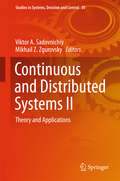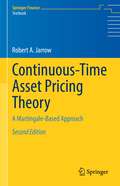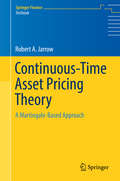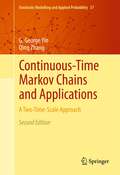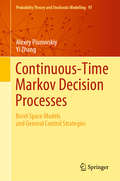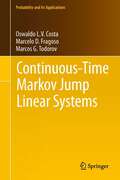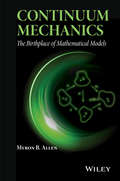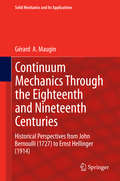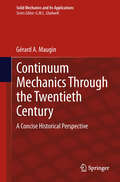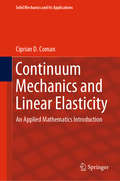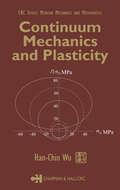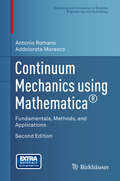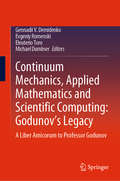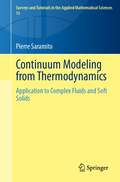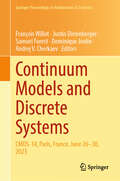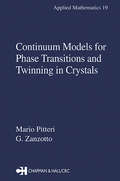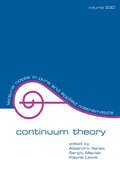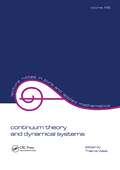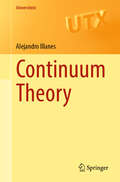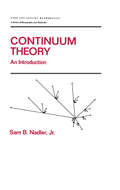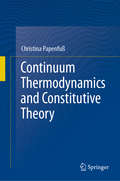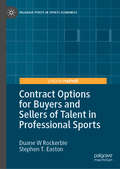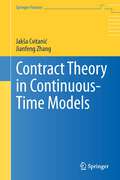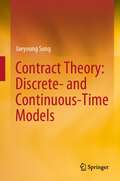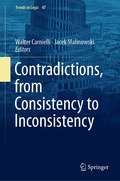- Table View
- List View
Continuous and Distributed Systems II: Theory and Applications (Studies in Systems, Decision and Control #30)
by Mikhail Z. Zgurovsky Viktor A. SadovnichiyAs in the previous volume on the topic, the authors close the gap between abstract mathematical approaches, such as applied methods of modern algebra and analysis, fundamental and computational mechanics, nonautonomous and stochastic dynamical systems, on the one hand, and practical applications in nonlinear mechanics, optimization, decision making theory and control theory on the other. Readers will also benefit from the presentation of modern mathematical modeling methods for the numerical solution of complicated engineering problems in biochemistry, geophysics, biology and climatology. This compilation will be of interest to mathematicians and engineers working at the interface of these field. It presents selected works of the joint seminar series of Lomonosov Moscow State University and the Institute for Applied System Analysis at National Technical University of Ukraine "Kyiv Polytechnic Institute". The authors come from Brazil, Germany, France, Mexico, Spain, Poland, Russia, Ukraine, and the USA.
Continuous-Time Asset Pricing Theory: A Martingale-Based Approach (Springer Finance)
by Robert A. JarrowAsset pricing theory yields deep insights into crucial market phenomena such as stock market bubbles. Now in a newly revised and updated edition, this textbook guides the reader through this theory and its applications to markets. The new edition features new results on state dependent preferences, a characterization of market efficiency and a more general presentation of multiple-factor models using only the assumptions of no arbitrage and no dominance. Taking an innovative approach based on martingales, the book presents advanced techniques of mathematical finance in a business and economics context, covering a range of relevant topics such as derivatives pricing and hedging, systematic risk, portfolio optimization, market efficiency, and equilibrium pricing models. For applications to high dimensional statistics and machine learning, new multi-factor models are given. This new edition integrates suicide trading strategies into the understanding of asset price bubbles, greatly enriching the overall presentation and further strengthening the book’s underlying theme of economic bubbles. Written by a leading expert in risk management, Continuous-Time Asset Pricing Theory is the first textbook on asset pricing theory with a martingale approach. Based on the author’s extensive teaching and research experience on the topic, it is particularly well suited for graduate students in business and economics with a strong mathematical background.
Continuous-Time Asset Pricing Theory: A Martingale-Based Approach (Springer Finance)
by Robert A. JarrowYielding new insights into important market phenomena like asset price bubbles and trading constraints, this is the first textbook to present asset pricing theory using the martingale approach (and all of its extensions). Since the 1970s asset pricing theory has been studied, refined, and extended, and many different approaches can be used to present this material. Existing PhD–level books on this topic are aimed at either economics and business school students or mathematics students. While the first mostly ignore much of the research done in mathematical finance, the second emphasizes mathematical finance but does not focus on the topics of most relevance to economics and business school students. These topics are derivatives pricing and hedging (the Black–Scholes–Merton, the Heath–Jarrow–Morton, and the reduced-form credit risk models), multiple-factor models, characterizing systematic risk, portfolio optimization, market efficiency, and equilibrium (capital asset and consumption) pricing models. This book fills this gap, presenting the relevant topics from mathematical finance, but aimed at Economics and Business School students with strong mathematical backgrounds.
Continuous-Time Markov Chains and Applications: A Two-Time-Scale Approach (Stochastic Modelling and Applied Probability #37)
by Qing Zhang G. George YinThis book gives a systematic treatment of singularly perturbed systems that naturally arise in control and optimization, queueing networks, manufacturing systems, and financial engineering. It presents results on asymptotic expansions of solutions of Komogorov forward and backward equations, properties of functional occupation measures, exponential upper bounds, and functional limit results for Markov chains with weak and strong interactions. To bridge the gap between theory and applications, a large portion of the book is devoted to applications in controlled dynamic systems, production planning, and numerical methods for controlled Markovian systems with large-scale and complex structures in the real-world problems. This second edition has been updated throughout and includes two new chapters on asymptotic expansions of solutions for backward equations and hybrid LQG problems. The chapters on analytic and probabilistic properties of two-time-scale Markov chains have been almost completely rewritten and the notation has been streamlined and simplified. This book is written for applied mathematicians, engineers, operations researchers, and applied scientists. Selected material from the book can also be used for a one semester advanced graduate-level course in applied probability and stochastic processes.
Continuous-Time Markov Decision Processes: Borel Space Models and General Control Strategies (Probability Theory and Stochastic Modelling #97)
by Yi Zhang Alexey PiunovskiyThis book offers a systematic and rigorous treatment of continuous-time Markov decision processes, covering both theory and possible applications to queueing systems, epidemiology, finance, and other fields. Unlike most books on the subject, much attention is paid to problems with functional constraints and the realizability of strategies.Three major methods of investigations are presented, based on dynamic programming, linear programming, and reduction to discrete-time problems. Although the main focus is on models with total (discounted or undiscounted) cost criteria, models with average cost criteria and with impulsive controls are also discussed in depth.The book is self-contained. A separate chapter is devoted to Markov pure jump processes and the appendices collect the requisite background on real analysis and applied probability. All the statements in the main text are proved in detail.Researchers and graduate students in applied probability, operational research, statistics and engineering will find this monograph interesting, useful and valuable.
Continuous-Time Markov Jump Linear Systems (Probability and Its Applications)
by Oswaldo Luiz Costa Marcelo D. Fragoso Marcos G. TodorovIt has been widely recognized nowadays the importance of introducing mathematical models that take into account possible sudden changes in the dynamical behavior of a high-integrity systems or a safety-critical system. Such systems can be found in aircraft control, nuclear power stations, robotic manipulator systems, integrated communication networks and large-scale flexible structures for space stations, and are inherently vulnerable to abrupt changes in their structures caused by component or interconnection failures. In this regard, a particularly interesting class of models is the so-called Markov jump linear systems (MJLS), which have been used in numerous applications including robotics, economics and wireless communication. Combining probability and operator theory, the present volume provides a unified and rigorous treatment of recent results in control theory of continuous-time MJLS. This unique approach is of great interest to experts working in the field of linear systems with Markovian jump parameters or in stochastic control. The volume focuses on one of the few cases of stochastic control problems with an actual explicit solution and offers material well-suited to coursework, introducing students to an interesting and active research area. The book is addressed to researchers working in control and signal processing engineering. Prerequisites include a solid background in classical linear control theory, basic familiarity with continuous-time Markov chains and probability theory, and some elementary knowledge of operator theory.
Continuum Mechanics
by Myron B. AllenPresents a self-contained introduction to continuum mechanics that illustrates how many of the important partial differential equations of applied mathematics arise from continuum modeling principles Written as an accessible introduction, Continuum Mechanics: The Birthplace of Mathematical Models provides a comprehensive foundation for mathematical models used in fluid mechanics, solid mechanics, and heat transfer. The book features derivations of commonly used differential equations based on the fundamental continuum mechanical concepts encountered in various fields, such as engineering, physics, and geophysics. The book begins with geometric, algebraic, and analytical foundations before introducing topics in kinematics. The book then addresses balance laws, constitutive relations, and constitutive theory. Finally, the book presents an approach to multiconstituent continua based on mixture theory to illustrate how phenomena, such as diffusion and porous-media flow, obey continuum-mechanical principles. Continuum Mechanics: The Birthplace of Mathematical Models features: Direct vector and tensor notation to minimize the reliance on particular coordinate systems when presenting the theory Terminology that is aligned with standard courses in vector calculus and linear algebra The use of Cartesian coordinates in the examples and problems to provide readers with a familiar setting Over 200 exercises and problems with hints and solutions in an appendix Introductions to constitutive theory and multiconstituent continua, which are distinctive for books at this level Continuum Mechanics: The Birthplace of Mathematical Models is an ideal textbook for courses on continuum mechanics for upper-undergraduate mathematics majors and graduate students in applied mathematics, mechanical engineering, civil engineering, physics, and geophysics. The book is also an excellent reference for professional mathematicians, physical scientists, and engineers.
Continuum Mechanics Through the Eighteenth and Nineteenth Centuries: Historical Perspectives from John Bernoulli (1727) to Ernst Hellinger (1914) (Solid Mechanics and Its Applications #214)
by Gérard A. MauginConceived as a series of more or less autonomous essays, the present book critically exposes the initial developments of continuum thermo-mechanics in a post Newtonian period extending from the creative works of the Bernoullis to the First World war, i. e. , roughly during first the "Age of reason" and next the "Birth of the modern world". The emphasis is rightly placed on the original contributions from the "Continental" scientists (the Bernoulli family, Euler, d'Alembert, Lagrange, Cauchy, Piola, Duhamel, Neumann, Clebsch, Kirchhoff, Helmholtz, Saint-Venant, Boussinesq, the Cosserat brothers, Caratheodory) in competition with their British peers (Green, Kelvin, Stokes, Maxwell, Rayleigh, Love,. . ). It underlines the main breakthroughs as well as the secondary ones. It highlights the role of scientists who left essential prints in this history of scientific ideas. The book shows how the formidable developments that blossomed in the twentieth century (and perused in a previous book of the author in the same Springer Series: "Continuum Mechanics through the Twentieth Century", Springer 2013) found rich compost in the constructive foundational achievements of the eighteenth and nineteenth centuries. The pre-WWI situation is well summarized by a thorough analysis of treatises (Appell, Hellinger) published at that time. English translations by the author of most critical texts in French or German are given to the benefit of the readers.
Continuum Mechanics Through the Twentieth Century: A Concise Historical Perspective (Solid Mechanics and Its Applications #196)
by Gerard A MauginThis overview of the development of continuum mechanics throughout the twentieth century is unique and ambitious. Utilizing a historical perspective, it combines an exposition on the technical progress made in the field and a marked interest in the role played by remarkable individuals and scientific schools and institutions on a rapidly evolving social background. It underlines the newly raised technical questions and their answers, and the ongoing reflections on the bases of continuum mechanics associated, or in competition, with other branches of the physical sciences, including thermodynamics. The emphasis is placed on the development of a more realistic modeling of deformable solids and the exploitation of new mathematical tools. The book presents a balanced appraisal of advances made in various parts of the world. The author contributes his technical expertise, personal recollections, and international experience to this general overview, which is very informative albeit concise.
Continuum Mechanics and Linear Elasticity: An Applied Mathematics Introduction (Solid Mechanics and Its Applications #238)
by Ciprian D. ComanThis is an intermediate book for beginning postgraduate students and junior researchers, and offers up-to-date content on both continuum mechanics and elasticity. The material is self-contained and should provide readers sufficient working knowledge in both areas. Though the focus is primarily on vector and tensor calculus (the so-called coordinate-free approach), the more traditional index notation is used whenever it is deemed more sensible.With the increasing demand for continuum modeling in such diverse areas as mathematical biology and geology, it is imperative to have various approaches to continuum mechanics and elasticity. This book presents these subjects from an applied mathematics perspective. In particular, it extensively uses linear algebra and vector calculus to develop the fundamentals of both subjects in a way that requires minimal use of coordinates (so that beginning graduate students and junior researchers come to appreciate the power of the tensor notation).
Continuum Mechanics and Plasticity (Modern Mechanics and Mathematics)
by Han-Chin WuTremendous advances in computer technologies and methods have precipitated a great demand for refinements in the constitutive models of plasticity. Such refinements include the development of a model that would account for material anisotropy and produces results that compare well with experimental data. Key to developing such models-and to meeting
Continuum Mechanics using Mathematica®: Fundamentals, Methods, and Applications (Modeling and Simulation in Science, Engineering and Technology)
by Antonio Romano Addolorata MarascoThis textbook's methodological approach familiarizes readers with the mathematical tools required to correctly define and solve problems in continuum mechanics. Covering essential principles and fundamental applications, this second edition of Continuum Mechanics using Mathematica® provides a solid basis for a deeper study of more challenging and specialized problems related to nonlinear elasticity, polar continua, mixtures, piezoelectricity, ferroelectricity, magneto-fluid mechanics and state changes (see A. Romano, A. Marasco, Continuum Mechanics: Advanced Topics and Research Trends, Springer (Birkhäuser), 2010, ISBN 978-0-8176-4869-5). Key topics and features: * Concise presentation strikes a balance between fundamentals and applications * Requisite mathematical background carefully collected in two introductory chapters and one appendix * Recent developments highlighted through coverage of more significant applications to areas such as wave propagation, fluid mechanics, porous media, linear elasticity. This second edition expands the key topics and features to include: * Two new applications of fluid dynamics: meteorology and navigation * New exercises at the end of the existing chapters * The packages are rewritten for Mathematica 9 Continuum Mechanics using Mathematica®: Fundamentals, Applications and Scientific Computing is aimed at advanced undergraduates, graduate students and researchers in applied mathematics, mathematical physics and engineering. It may serve as a course textbook or self-study reference for anyone seeking a solid foundation in continuum mechanics.
Continuum Mechanics, Applied Mathematics and Scientific Computing: A Liber Amicorum to Professor Godunov (Advanced Structured Materials Ser. #107)
by Gennadii V. Demidenko Evgeniy Romenski Eleuterio Toro Michael DumbserThis book is a liber amicorum to Professor Sergei Konstantinovich Godunov and gathers contributions by renowned scientists in honor of his 90th birthday. The contributions address those fields that Professor Godunov is most famous for: differential and difference equations, partial differential equations, equations of mathematical physics, mathematical modeling, difference schemes, advanced computational methods for hyperbolic equations, computational methods for linear algebra, and mathematical problems in continuum mechanics.
Continuum Modeling from Thermodynamics: Application to Complex Fluids and Soft Solids (Surveys and Tutorials in the Applied Mathematical Sciences #13)
by Pierre SaramitoThis book presents a novel comprehensive thermodynamic framework, suitable for the design of new macroscopic models, as well as the combination of existing models. Our goal is to popularize thermodynamics for model designers. The example series of models includes very classic solid and fluid models, such as Newtonian, viscoplastic and viscoelastic materials, but also new heat effects and original combinations of existing models. The aim of the new proposed framework is to allow a clear and easy development of constitutive equations that automatically satisfy the second principle. Instead of writing directly constitutive relations, model designers are encouraged to first specify the energy. This book is primarily intended for graduate students and researchers in applied mathematics, engineering sciences, computational mechanics and physics. The reader is assumed to be familiar with classical mechanics, together with matrix and tensors algebra.
Continuum Models and Discrete Systems: CMDS-14, Paris, France, June 26–30, 2023 (Springer Proceedings in Mathematics & Statistics #457)
by Samuel Forest Andrej V. Cherkaev Dominique Jeulin François Willot Justin DirrenbergerThe present book contains the proceedings of the 14th International Symposium on Continuum Models and Discrete Systems (CMDS14) held in Paris in June 2023. It contains 21 contributions that cover a broad range of topics in the wide field of mechanics and physics of heterogeneous media for discrete and continuous systems, from image analysis to models of random structures and to homogenization. The sessions in the CMDS conference series cover, in particular, the modeling of complex heterogeneous systems and metamaterials, structures and composites with extreme properties, deformable solids with microstructures, generalized continua, fracture and defect dynamics, fatigue, design of structured and architectured materials, micro and nanostructures, thermodynamics, transport theory and multiphysics coupling and methods ranging from homogenization theories to optimal design and machine-learning frameworks. Papers in the present volume are organized according to the following six main topics: probabilistic models, homogenization, solid mechanics, architectured materials, optics and metamaterials, machine learning methods.
Continuum Models for Phase Transitions and Twinning in Crystals (Applied Mathematics)
by Mario Pitteri G. ZanzottoContinuum Models for Phase Transitions and Twinning in Crystals presents the fundamentals of a remarkably successful approach to crystal thermomechanics. Developed over the last two decades, it is based on the mathematical theory of nonlinear thermoelasticity, in which a new viewpoint on material symmetry, motivated by molecular theories, plays a c
Continuum Theory
by Sergio Macías Wayne Lewis Alejandro IllanesCelebrating the work of world-renowned mathematician Sam B. Nadler, Jr., this reference examines the most recent advances in the analysis of continua. The book offers articles on the contributions of Professor Nadler, theorems on the structure and uniqueness of hyperspaces, results on the dynamics of solenoids, examples involving inverse limits of
Continuum Theory & Dynamical Systems (Lecture Notes in Pure and Applied Mathematics)
by Thelma WestBased on the conference/workshop on Continuum Theory and Dynamical Systems held in Lafayette, Louisiana, this reference illustrates the current expansion of knowledge on the relationship between these subjects. It presents new problems in hyperspaces, induced maps, universal maps, fixed-point sets, disconnected numbers and quotient maps.;Explaining the definitions and techniques used in the two fields and providing results from both areas, this volume: examines prime end (accessible) rotation numbers for chaotic sets and Henon maps; discussed the connection between the rotation shadowing property and the structure of the rotation set for annulus homeomorphisms; offers a Nielson-type theorum concerning the minimum number of fixed points for an area preserving homeomorphism of the two disc; constructs a closed unit disc that admits many inequivalent homeomorphisms that are Denjoy on the boundary and distinct irrational rotations on the interior; gives a geometric description of a horseshoe-type mapping of a plane disc into itself whose attracting set is not chainable; and considers semigroups generated by maps topologically conjugate to contractions.;Written by experts who provide a cross-disciplinary perspective, this volume is intended for applied mathematicians, topologists, geomesters, physicists and graduate-level students in these disciplines.
Continuum Theory (Universitext)
by Alejandro IllanesThis graduate textbook provides a natural and structured introduction to Continuum Theory, guiding readers from fundamental concepts to advanced topics. It covers classical results such as locally connected continua, indecomposable continua, arcs, circles, finite graphs, dendroids, and the relationship between the Cantor set and continua. The second half explores the theory of hyperspaces, presenting various models, their properties, and key theorems, while also highlighting elegant and lesser-known mathematical results. Designed for readers with an understanding of basic topology, this book serves as a valuable resource for PhD students and researchers in mathematics. It offers a rigorous and thorough approach, with detailed proofs that clarify complex arguments—especially regarding the intricate properties of the pseudo-arc. A wealth of exercises helps reinforce understanding and develop problem-solving skills. This book stands out for its depth and breadth, covering a range of topics. It provides a comprehensive study of hyperspace models, the homogeneity of the Hilbert cube, and the pseudo-arc, offering one of the few accessible and complete proofs of its unique properties. With its structured progression and careful exposition, this book is a valuable reference for anyone interested in continuum theory.
Continuum Theory: An Introduction (Chapman & Hall/CRC Pure and Applied Mathematics)
by Sam NadlerA textbook for either a semester or year course for graduate students of mathematics who have had at least one course in topology. Introduces continuum theory through a combination of classical and modern techniques. Annotation copyright Book News, Inc. Portland, Or.
Continuum Thermodynamics and Constitutive Theory
by Christina PapenfußThis book presents different thermodynamic approaches in the area of constitutive theory: thermodynamics of irreversible processes, rational thermodynamics, and extended thermodynamics. These different approaches are analyzed with respect to their presuppositions, as well as to their results, and each method is applied to several important examples. In many cases these examples are archetypes for numerous technologically important materials; i.e. complex materials having an internal structure. Some of the examples dealt with in this book are liquid crystals, colloid suspensions, ans fiber suspensions. The book well serves students and researchers who have basic knowledge in continuum mechanics and thermodynamics. It provides a systematic overview of the vast field of thermodynamic constitutive theory, beginning from a historical perspective and concluding with outstanding questions in recent research.
Contract Options for Buyers and Sellers of Talent in Professional Sports (Palgrave Pivots in Sports Economics)
by Duane W Rockerbie Stephen T. EastonThis Palgrave Pivot re-examines salary formation in Major League Baseball in light of real option theory to clarify the connection between salary and marginal revenue product for professional baseball players. Current literature has tended to treat single-year and multi-year contracts similarly, ignoring the potential option value for teams and for players. Recent work points to the observation that both high-productivity and low-productivity athletes have salaries that systematically differ from their marginal revenue product, and that free agents signing multi-year contracts are overpaid relative to free agents signing one-year contracts. This book argues that the value of signing an athlete to a contract should be determined similarly to the determination of the value of an investment project or a financial asset. This book demonstrates how to calculate the value of real options to the player and the team owner with a simple two-year contract, and offers extensions to the real options model for multiyear contracts or when a player is early or late in his career.
Contract Theory in Continuous-Time Models (Springer Finance)
by Jianfeng Zhang Jakša CvitanicIn recent years there has been a significant increase of interest in continuous-time Principal-Agent models, or contract theory, and their applications. Continuous-time models provide a powerful and elegant framework for solving stochastic optimization problems of finding the optimal contracts between two parties, under various assumptions on the information they have access to, and the effect they have on the underlying "profit/loss" values. This monograph surveys recent results of the theory in a systematic way, using the approach of the so-called Stochastic Maximum Principle, in models driven by Brownian Motion. Optimal contracts are characterized via a system of Forward-Backward Stochastic Differential Equations. In a number of interesting special cases these can be solved explicitly, enabling derivation of many qualitative economic conclusions.
Contract Theory: Discrete- and Continuous-Time Models
by Jaeyoung SungThis book provides a self-contained introduction to discrete-time and continuous-time models in contracting theory to advanced undergraduate and graduate students in economics and finance and researchers focusing on closed-form solutions and their economic implications. Discrete-time models are introduced to highlight important elements in both economics and mathematics of contracting problems and to serve as a bridge for continuous-time models and their applications. The book serves as a bridge between the currently two almost separate strands of textbooks on discrete- and continuous-time contracting models This book is written in a manner that makes complex mathematical concepts more accessible to economists. However, it would also be an invaluable tool for applied mathematicians who are looking to learn about possible economic applications of various control methods.
Contradictions, from Consistency to Inconsistency (Trends in Logic #47)
by Walter Carnielli Jacek MalinowskiThis volume investigates what is beyond the Principle of Non-Contradiction. It features 14 papers on the foundations of reasoning, including logical systems and philosophical considerations. Coverage brings together a cluster of issues centered upon the variety of meanings of consistency, contradiction, and related notions. Most of the papers, but not all, are developed around the subtle distinctions between consistency and non-contradiction, as well as among contradiction, inconsistency, and triviality, and concern one of the above mentioned threads of the broadly understood non-contradiction principle and the related principle of explosion. Some others take a perspective that is not too far away from such themes, but with the freedom to tread new paths. Readers should understand the title of this book in a broad way,because it is not so obvious to deal with notions like contradictions, consistency, inconsistency, and triviality. The papers collected here present groundbreaking ideas related to consistency and inconsistency.
